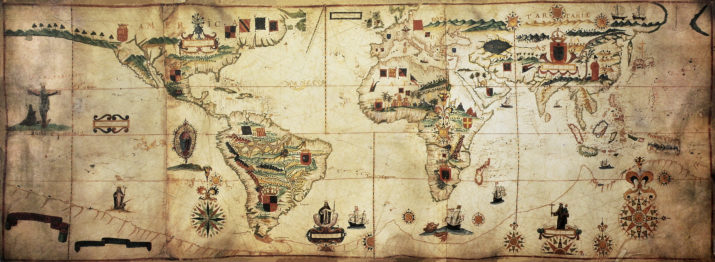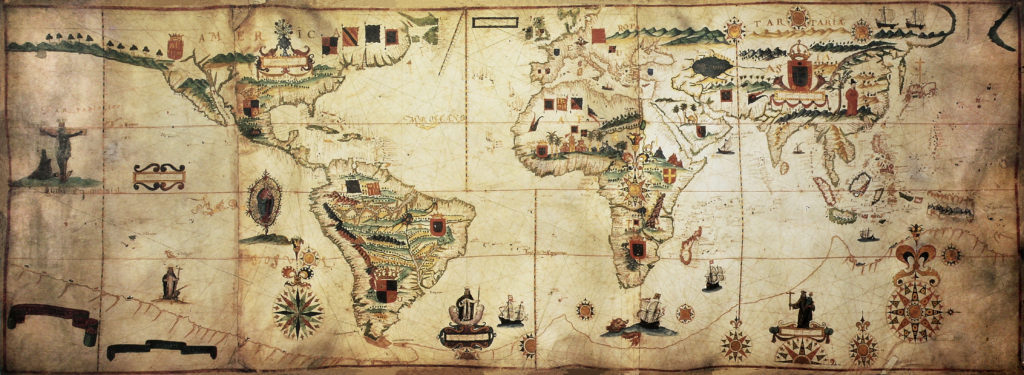

This is part of our special feature, Confronting Waste.
On January 25, 2019, the waste tailings pond of Brazil’s Córrego do Feijão iron ore mine burst, causing a catastrophic mudslide that flowed uncontrollably for several hundred kilometers. The scale of this environmental disaster is difficult to fathom; some 12 million cubic meters of tailings is currently making its way through five different Brazilian states, on its way to the South Atlantic Ocean, as well as two enormous hydroelectric dams. The death toll remains undetermined; authorities have confirmed 209 dead, with at least another 102 people missing. The mine (and its waste) is owned by Vale Canada Limited, a multinational mining corporation with headquarters in Toronto, Canada. At Vale’s sister company in Brazil, president Fabio Schvartsman unsurprisingly attempted to downplay this particular mining disaster by referring to yet another catastrophic Brazilian mining disaster just four years earlier: “I believe that the environmental risk, in this case, will be much lower than that of Mariana” (Mendes and DeSalvo 2018: np). The Samarco company, owner of the Bento Rodrigues dam in Mariana, is itself a joint Brazilian Vale and English-Australian BHP venture. “The trouble with normal,” as Bruce Cockburn writes, “is it always gets worse.”
As well as downplaying the scale of these disasters, Vale and BHP officials are (also unsurprisingly) attempting to minimize their liability even while the Brazilian government has imposed fines and sanctions. Local and international environmental and social justice organizations are raising critical questions about the responsibilities of the extractive industry to local populations. And these questions cannot be meaningfully answered without acknowledging the entangled relationship between the extractive industry and ongoing imperialism and settler colonialism. Continuing a long colonial tradition of resource extraction, European and North American corporations are land-grabbing in Africa, South America, the Middle East, and Asia, in order to extract minerals and increase food (and increasingly biofuel) production for export (Broughton 2013).
Worldwide, colonialism continues to structure the relationship between the resource industry, Indigenous peoples, and the environment, as dwindling primary resources are pushing extraction efforts further and deeper into Indigenous territories. While governments and industry emphasize the potential to create new jobs for Indigenous peoples, alongside more people and equipment moving into Indigenous territories and significantly more drilling and extraction, one consequence is certain: the creation of more (and increasingly complex) forms of waste. This paper analyzes the ideologies that undergird ongoing colonial approaches to land and life. On a global scale, waste, we argue—as material object, as concept, as symbol, and as leitmotif—is a symptom of colonialism, and indeed, cannot be meaningfully understood detached from historical and ongoing forms of colonialism (Hird and Zahara 2017; Liboiron 2018).
Canada is a nation-state born from the imperial European powers of England and France. Once a colony of the so-called Old World, Canada has become a colonizing economy of its own— stealing land and water from Indigenous nations within its borders, as well as exploiting far off lands worldwide to meet its own imperial demands. In this paper, we chart the entangled relationship between historical and ongoing colonialism through which colonized Indigenous lands become a colonizing country (Canada). We illustrate that waste is a symptom of ongoing colonialism and, as such, we argue that responsibility for the monumental waste issues that resource extraction entails extends beyond current environmental legislation and weak promises of remediation. While oil and gas, forestry, agriculture, nuclear energy, and hydroelectricity industries are equally important to address, we use mineral resource extraction to illustrate the ideology behind global waste legacy and current practices.
Colonial Concepts of Waste
How we think about the term “waste” reveals much about our relationship with land and water. Colonization by Judeo-Christian nations such as France, the United Kingdom, Belgium, the Netherlands, and Spain was historically—and we argue still is—maintained through an ideology that not only prioritizes land and water ownership at all costs, but defines ownership in terms of specific forms of utilization (Saul 2008). The language used to describe land and water speaks to this ideology. According to Eleanor Johnson (2012), “waste” derives from the Latin term, vasto, “to empty” and describes land being despoiled and emptied of its contents. In Old and Middle English, “waste” referred generally to the environment, and more specifically to uninhabitable land. In the 1200s, the Anglo-French word for waste meant “desolate regions” and in Old North French it referred to “damage, destruction, wasteland, or moor.” By c. 1300, the Old English word “waste” meant “a desert, a wilderness” from the Latin “empty, desolate, waste” (see Hird 2016). Drawing upon the imperial Spanish ideology of the papal bulls, as well as the corresponding Doctrine of Discovery and terra nullius (land belonging to nobody, or empty land), colonial nation states have devastated lands and peoples in the name of control and domination: “The colonizers created a legal order and consciousness around the sovereign or state, that great fictitious entity of Eurocentric thought by which everyone seeks to live at the expense of everyone else, especially Indigenous peoples and their resources” (Youngblood Henderson 2000: 28).
Into the 1600s, European notions of waste still referred to land that was “unfit for use.” Land which appeared so desolate, and inhospitable, was synonymous with wilderness. Wilderness, in short, was wasted land: a wasteland. Within this ideology, the very inhospitality of wastelands obligated good Christians to bring these lands under control, under Christian sovereignty, to redeem these barren lands through utilization:
God, when he gave the world in common to all mankind [sic], commanded man also to labour, and the penury of his condition required it of him. God and his reason commanded him to subdue the earth, i.e. improve it for the benefit of life, and therein lay out something upon it that was his own, his labour. (Locke 1869/2017: section 25, chapter 5)
Land redeemed by Man for God is land that is comprehensible to Judeo-Christian ideology. It is claimed, marked, subdued, and utilized (Scanlan 2005). And any non-Christian heathens found on this land (i.e. Indigenous peoples) must likewise be subdued (become Christian, and thus engage in Christian land-use practices) or excised (through genocide) in order that the land may be put to God’s work, as God intended. That is, those human beings found on the land—like the flora and fauna—must either come to accept the inalienable sovereignty of (Judeo-Christian) God’s plan for His earth as actualized by colonial settlers, or be treated as waste. Indeed, the Indigenous peoples whom British and French colonizers encountered were already considered an inferior human kind, morally and practically disposable, if unsalvageable through Christian indoctrination.
Interestingly, colonialism outlasted the supremacy of the Church and the Enlightenment alike. Charting the history of empire in Europe, the Judeo-Christian ideology emerged and continued to disconnect people from their relationships with the Earth. Later, Enlightenment thinkers such as Thomas Hobbes, who were praised for being rational and reasonable, still viewed land and nature as separate and savage. Instead of God compelling people to conquer lands, European (men) imposed a civil society, or artificial man-state (Youngblood Henderson, 2000). In Utopian Legacies, Haudenosaunee (Seneca) scholar John Mohawk points to resource extraction, depletion and waste as byproducts of the utopian dream mentality of the West:
Even in contemporary times the pursuit of the ideal, like the pursuit of utopia, is usually destructive… The ideals that are pursued by those in power rarely concern such matters as harmonious relations among peoples or the regeneration of the ecology of a distressed region. They are almost always ideals that, if pursued, involve some level of dispossession, removal of populations, exploitation, pollution, economic devastation, or other evil. These tendencies have not existed in every culture in the world or at every moment of history, but it is important to acknowledge that they are major themes—perhaps the characterizing themes—in Western culture. (2000: 13)
Three waves of European colonialism have dominated the world. The initial disconnect and separation of our relationship with land and water occurred through the establishment and conquest of European empires. Once colonial thinking had overtaken the peoples of Europe, imperial ideologies were exported to the Americas to colonize Indigenous peoples and lands in places like present-day (so-called) Canada. Today, Canada continues to colonize within its borders, as well as distant lands, using the same ideologies of utopia and progress that were used to justify its own nation-building mythology.
Wasting Colonies
This European ideology had, and continues to have, ripple effects that extend far beyond Europe. Colonized, Canada has both internalized colonial ideology in its domination of Indigenous nations, and now exports European ideals of land exploitation to every corner of the globe through its extractive industries. Under the guise of globalization, entrepreneurialism, and innovation, colonialism is the extension of empire, rooted in imperial ideologies of power, land dispossession, resource extraction, and waste. As the ultimate environmental issue, colonialism perpetually seeks more than it can ever replenish. In this way, waste is both a symptom of colonialism and a perpetuating cycle of production, consumption and disposal, as lands and waters are continually destroyed for (assumed) limitless market expansion.
To wit, mining is a staple of the Canadian economy. Both within and beyond Canada, the majority of mining companies worldwide are Canadian owned and operated (Government of Canada 2019). While approximately half of the world’s mining companies are traded on the Toronto Stock Exchange (TSX and TSX-Venture Exchanges), most of the world’s publicly listed mining and exploration companies are headquartered in Canadian cities. These mining companies practice land-grabbing and exploitation within Canada and beyond (Runyan 2018). Bearing in mind that mining companies consider 95 to 99.9 percent of the physical material they extract from the earth to be waste, Canadian mining companies are creating and largely abandoning an unfathomable amount of often highly contaminated and toxic waste in their wake (see Hird 2017). For instance, Imperial Metals is a Canadian mining corporation with controversial operations within Canada. The company and its subsidiary, Mount Polley Mining Corporation, was responsible for a massive tailings spill in August 2014, similar to Vale’s Córrego do Feijão tailings spill in 2019. Imperial Metals also operates the Red Chris mine in the Canadian province of British Columbia. This mining project in the renowned Sacred Headwaters of three salmon-bearing rivers has been continually opposed by Indigenous peoples throughout the region (Neu and Therrien 2003).
A more expansive definition of waste, such as Zygmunt Bauman’s (2004), would certainly call attention to the ”bare life” conditions with which communities in the globalized south live and die (see also Agamben 1996; Davis 2007; Hecht 2014). Beyond its territorial boundaries, Canadian mining also has a violent relationship with the land, water and peoples throughout Latin America, including Mexico, El Salvador and Ecuador. The controversial Marlin Mine in Guatemala for instance, owned by the Canadian company Goldcorp, has been associated with extreme violence and death threats toward local Maya communities (Imai et al. 2017). Another Guatemalan example, the Fenix nickel mine near the town of El Estor in Maya Q’eqchi’ territory, has caused considerable harm as Indigenous people were forcibly removed to allow nickel mining activity. Several Canadian companies have owned this project since the 1960s. Murders, sexual assaults, and other human rights violations have taken place as a result of the conflict between local Indigenous people and successive Canadian corporate entities, including INCO, Skye Resources, HudBay Minerals, and their Guatemalan subsidiaries (Imai et al. 2012; 2017). Communities affected by this mining have sought justice in the Canadian courts. However, it is difficult to hold these companies to account within the void of Canadian corporate responsibility legislation. Meanwhile, Barrick Gold Corporation, another Canadian venture and the largest gold mining company in the world, has since been implicated in sexual assault and other violent assaults against people in Papua New Guinea and Tanzania. Forced eviction and land dispossession are common, especially amid the complex context of the corporate-government armed security apparatus (MiningWatch Canada 2017). And all too often these violent acts take place against a backdrop of serious environmental impacts and waste issues. First colonized by Europe, Canada now colonizes.
Paradise Lost
The Anthropocene, we might say, is a geologic literalization of Judeo-Christian ideology (Hird 2016, 2017b, 2017c). This particular ideology, in which all of the characteristics of colonizing—land grabbing, working land and its peoples with relentless brutality, violently displacing Indigenous living systems—has led to a planet exhausted by human exploitation. The Anthropocene, in other words, marks a geologic, cultural and political “afterword” to the Christian story. Reflecting upon Edward Burtynsky’s photographic witness to the Anthropocene in Manufactured Landscapes (2004), Jonathan Bordo suggests these images record:
…the wilderness as a fallen condition; not the condition of the first fall and expulsion of humans from the garden into the wilderness; not the wilderness of the commons; but the wilderness of the second fall, the wilderness turned into wasteland, the earth itself turned into exploited ruin. (2006: 5)
Indeed, those cultures that are tied to Western notions of progress and faith, which are ever upward-looking, fail to recognize the sacred nature of the Earth and the finite reality of the planet’s natural limits. Beyond laying the landscape to waste, the byproduct of unregulated consumption is the physical waste itself. Complex forms of waste impact entire ecosystems through leachate, contaminants and toxins, which have implications for all forms of life. As Anishinaabekwe scholar Winona LaDuke writes, “Colonization is the process of being consumed”, likening the word colon to digestion (in Dunlap 2014: 63). In other words, colonialism is akin to a snake eating its own tail. If we stay the current course of extraction and waste, the process will continue until the entire planet has been consumed.
As authors with settler colonial heritage, it is not for us to speculate about Indigenous understandings of waste or indigenizing perceptions of waste. As critics of our settler colonial inheritance, however, we may articulate how waste is a symptom of Canada’s colonial legacy and contemporary ideology. We recognize that Indigenous peoples in Canada and the world over remain at the frontlines of extraction and waste impacts, and the responsibility for restoring degraded ecosystems is often downloaded to local communities. Reconciliation efforts will be in vain if land and water is contaminated and destroyed. By identifying waste as colonial, and taking measures to return healthy land and water to Indigenous peoples, we seek to decolonize our relationship with the Earth on which we live and depend. As Haudenosaunee (Mohawk) scholar Dr. Dan Longboat insists, “We all have a responsibility to care for the planet. We must fulfill our sacred obligation to restore Mother Earth from the degradation that Western culture has caused, and to work for the continuation of All Life.”
James Wilkes is an instructor in the Indigenous Environmental Studies & Sciences Program at Trent University and a PhD candidate in the School of Environmental Studies at Queen’s University. James situates himself as a settler and immigrant Canadian in transformation away from empire, and towards naturalized ways of living and being in place. His current research focus is on the assertion of Indigenous law and autonomy in environmental decision-making.
Myra J. Hird is Professor, Fellow of the Royal Society of Canada, and Queen’s National Scholar in the School of Environmental Studies, Queen’s University (www.myrahird.com). Professor Hird is Director of Waste Flow, an interdisciplinary research project focused on waste as a global scientific-technical and socio-ethical issue (www.wasteflow.ca). Hird has published nine books and over seventy articles and book chapters on a diversity of topics relating to science studies.
References
Agamben, G. (1995) Homo Sacer: Sovereign Power and Bare Life. Stanford, CA: Stanford University Press.
Bauman, Z (2004) Wasted Lives: Modernity and its Outcasts. Oxford: Polity Press.
Bordo, J. (2003) ‘The Keeping Place (Arising from an Incident on the Land)’ in R. Nelson and M. Okin (eds.) Monuments and Memory, Made and Unmade. Chicago: The University of Chicago Press, pp. 157-182.
Bordo, J. (2006) ‘The Wasteland – An Essay on Manufactured Landscapes’ Material Culture Review, 63: 1-7.
Broughton, A. (2013) ‘Land Grabbing: A New Colonialism’ Green Social Thought, 61: 25-29.
Davis, M. (2007) Planet of Slums. New York: Verso.
Dunlap, A. (2014) ‘Permanent War: Grids, Boomerangs, and Counterinsurgency’ Anarchist Studies, 22(2): 55-79.
Government of Canada (2019) Canadian Mining Assets. Natural Resources Canada.
Hecht, G. (2012) Being Nuclear: Africans and the Global Uranium Trade. Cambridge, MA: The MIT Press.
Hird, M.J. (2016) ‘Waste Legacies: Land, Waste, and Canada’s DEW Line’, Northern Research, 42: 173-195.
Hird, M.J. (2017a) ‘Burial and Resurrection in the Anthropocene: Infrastructures of Waste’ in P. Harvey, C. Bruun Jensen and A. Morita (eds.) Infrastructures and Social Complexity: A Routledge Companion, pp. 242-252.
Hird, M.J. (2017b) ‘Proliferation-Extinction-Anxiety and the Anthropocene Aesthetic’ in J. Weinstein and C. Colebrook (eds.) Inhuman Life and Posthuman Rights. Columbia University Press, pp. 251-270.
Hird, M.J. (2017c) ‘Waste, Environmental Politics and Dis/Engaged Publics’ Theory, Culture and Society, 34(2-3): 187-209.
Hird, M.J. and Zahara, A. (2017) ‘The Arctic Wastes’ in Grusin, R. (ed) Anthropocene Feminism. University of Minnesota Press, pp.121-145.
Imai, S., Maheandiran, B., & Crystal, V. (2012). Accountability across borders: Mining in Guatemala and the Canadian justice system. Comparative Research in Law & Political Economy. Research Paper No. 26.
Imai, S., Gardner, L., & Weinberger, S. (2017, December 1). The “Canada Brand”: Violence and Canadian Mining Companies in Latin America (pdf, version 3). Toronto: Osgoode Law School, York University.
Johnson, E. (2012) “The Poetics of Waste: Medieval English Ecocriticism,” Modern Language Association, 127(3): 460–476.
LaDuke, W. (2015) The Winona LaDuke Chronicles: Stories from the Front Lines in the Battle for Environmental Justice. Black Point, Nova Scotia: Fernwood Publishing.
Liboiron, M. (2018) ‘Waste Colonialism’ Discard Studies. https://discardstudies.com/2018/11/01/waste-colonialism/Accessed 15 February 2019.
Locke, J. (1869/2017) Second Treatise of Civil Government.Archived from the original by britannica.com.
Mendes, K. and DeSalvo, M.P. (2018) ‘The Causes of the 2015 Mariana Tragedy’ The Brazilian Report. https://brazilian.report/society/2018/11/05/causes-mariana-tragedy/
MiningWatch Canada (2017) ‘Barrick Gold Tanzania Operations Accused of Financial and Human Rights Abuses — Executives Once Again Fail to Address Human Rights Abuses’ https://www.globenewswire.com/news-release/2017/07/05/1055022/0/en/MiningWatch-Canada-Issues-Statement-Regarding-Barrick-Gold-Tanzania-Operations.html
Mohawk, J. (2000) Utopian Legacies: A History of Conquest and Oppression in the Western World. Santa Fe, NM: Clear Light Publishers.
Neu, D. and Therrien, R. (2003) Accounting for Genocide: Canada’s Bureaucratic Assault on Aboriginal People. Black Point, Nova Scotia: Fernwood Publishing.
Runyan, A.S. (2018) ‘Disposable Waste, Land and Bodies under Canada’s Gendered Nuclear Colonialism’ International Feminist Journal of Politics, 20(1): 24-38.
Saul, J.R. (2008) A Fair Country: Telling Truths About Canada. Toronto: Penguin Canada.
Scanlan, J. (2005) On Garbage. London: Reaktion Books.
Vasudevan, P. (2019) ‘An Intimate Inventory of Race and Waste’ Antipode(pages forthcoming).
Youngblood Henderson, J. (2000). The context of the state of nature. In M. Battiste (Ed.), Reclaiming Indigenous voice and vision. Vancouver, BC: UBC Press.
Zahara, A. and Hird, M.J. (2015) ‘Raven, Dog, Human: Inhuman Colonialism and Unsettling Cosmologies’, ‘Learning How to Inherit in Colonized and Ecologically Challenged Lifeworlds’ special issue of Environmental Humanities, 7: 169-190.
Photo: Old map Europe with parallels and meridians. May be dated to the end of XVII sec | Shutterstock
Published on May 7, 2019.




